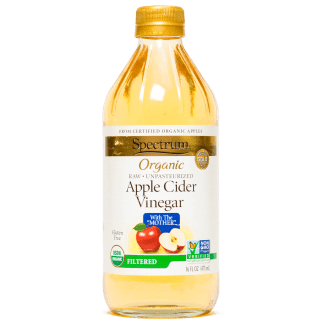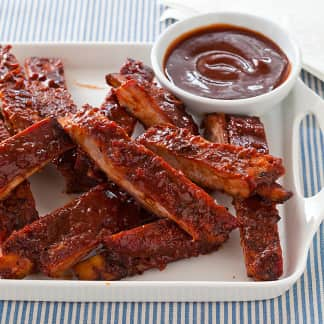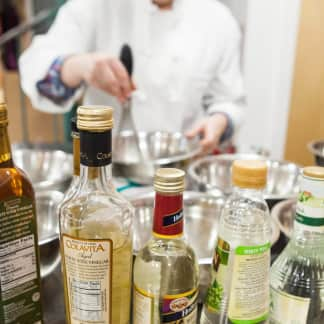Just as Italy is known for balsamic vinegar and Spain for sherry vinegar, America has a vinegar to lay claim to: apple cider vinegar. Cider vinegar is a natural byproduct of apple cider—left to sit long enough, the sugar in the apples will convert to alcohol and then to acetic acid. Cider vinegar has been around since at least 2500 BC, and it has been produced in the United States since the colonial days. Before the advent of refrigeration, most American homes kept cider vinegar on hand for preserving, cooking, and cleaning.
These days, we use apple cider vinegar for a comparatively mellow, slightly sweet kick of acidity in glazes, slaws, and sauces. We’re particularly keen on using it in fall dishes, where the apple notes complement other seasonal ingredients. Since we last tasted apple cider vinegar, our former winning product by French manufacturer Maille has become hard to find in the United States. We wanted to see if there was a better, more widely available option.

We rounded up six American-made cider vinegars and asked 21 America’s Test Kitchen staffers to sample the products plain, cooked into a pan sauce, stirred into coleslaw, and mixed into a barbecue sauce. Every vinegar we tried worked fine. That said, tasters zeroed in on some characteristics that separate vinegar that’s “fine” from vinegar that’s really good.
Cider will convert naturally to vinegar with time, but manufacturers typically speed up the process by adding a “mother,” which is bacteria from an established vinegar. Once all the alcohol is converted to acid (there’s no measurable alcohol in vinegar), the vinegar is either filtered to remove the cloudy sediment of leftover mother or bottled unfiltered. In the plain tasting, testers could visually identify the unfiltered vinegars by their darker, hazier appearance and small floating particles. While tasters didn’t notice any difference in consistency when tasting filtered and unfiltered products, many thought the unfiltered vinegars were slightly more complex—fruity, floral, and appley—when sampled straight.

These nuances were still prominent when we tasted the vinegars in a subtle pan sauce, where tasters preferred the fruitiness and slightly funky liveliness of unfiltered products. But the lines between filtered and unfiltered started to blur when we tried the vinegars in barbecue sauce and slaw, punchy foods with lots of competing flavors. In these applications, tasters wanted a bright, bold kick of tartness and preferred products they perceived as more acidic—regardless of whether they were filtered or unfiltered.
But more acidity wasn’t always a good thing. One product was slightly too tangy and overwhelmed the mellow pan sauce with its harsher tartness. To get a better read on acidity, we sent the vinegars to an independent lab for analysis. There was no clear correlation between acidity and whether the vinegars were filtered or not. All the products contained between 5.0 percent and 5.3 percent acid, with tasters giving the edge to products that fell in the middle, at around 5.1 percent acid. Though this may seem like a relatively small range, our science editor confirmed that it’s actually pretty significant when measuring acidity. Products with any less acid lacked brightness in more flavorful recipes, while vinegars that were more acidic overpowered delicate dishes. Products that met in the middle worked well in every recipe we tried, lending a lively bite to edgier dishes without washing out the mellower ones.


Before sending samples to an independent lab for evaluation, we conducted some in-house pH testing to better understand the products’ differences in acidity and to see how those differences correlated with tasters’ preferences.
The one exception was our runner-up, which, at 5.3 percent acid, was the most acidic product in the lineup. Lab tests showed, however, that this was the only vinegar we tasted that was also measurably sweet, at 1.4 percent sugar compared with 0 percent in every other product. Manufacturers don’t add sugar to vinegar; instead, this product’s manufacturer likely started with a sweeter cider and stopped fermentation before all the sugars were converted to acid. Tasters thought the extra sugar in this vinegar helped amplify its apple flavor and temper its higher acidity.
Our favorite was a well-rounded, versatile vinegar that worked well in every recipe. Fortunately, it’s also the one you’re most likely to encounter at the supermarket. Heinz Filtered Apple Cider Vinegar enlivened pan sauce, tempered sweet slaw, and balanced barbecue sauce with its bright, moderate acidity and clear apple notes. It’s also one of the cheapest cider products we found, proving that you don’t have to shell out extra for great apple cider vinegar.
- Straight from the bottle
- Cook into Vinegar-Tarragon Pan Sauce
- Whisk into White Barbecue Sauce
- Toss into Sweet and Tangy Coleslaw
- Send to lab to analyze acidity and sugar content
- Filtered
- Moderate acidity
- Prominent apple notes












